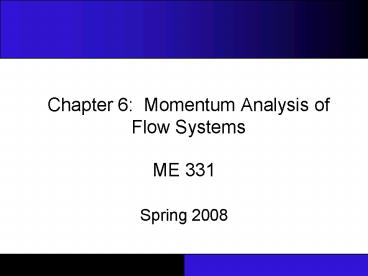Chapter 6: Momentum Analysis of Flow Systems - PowerPoint PPT Presentation
Title:
Chapter 6: Momentum Analysis of Flow Systems
Description:
the translational motion of its center of mass (Ux, Uy, Uz) ... Together, the body motion can be described as a 6 degree of freedom (6DOF) system. ... – PowerPoint PPT presentation
Number of Views:83
Avg rating:3.0/5.0
Title: Chapter 6: Momentum Analysis of Flow Systems
1
Chapter 6 Momentum Analysis of Flow Systems
- ME 331
- Spring 2008
2
Introduction
- Fluid flow problems can be analyzed using one of
three basic approaches differential,
experimental, and integral (or control volume). - In Chap. 5, control volume forms of the mass and
energy equation were developed and used. - In this chapter, we complete control volume
analysis by presenting the integral momentum
equation. - Review Newton's laws and conservation relations
for momentum. - Use RTT to develop linear and angular momentum
equations for control volumes. - Use these equations to determine forces and
torques acting on the CV.
3
Objectives
- After completing this chapter, you should be able
to - Identify the various kinds of forces and moments
acting on a control volume. - Use control volume analysis to determine the
forces associated with fluid flow. - Use control volume analysis to determine the
moments caused by fluid flow and the torque
transmitted.
4
Newtons Laws
- Newtons laws are relations between motions of
bodies and the forces acting on them. - First law a body at rest remains at rest, and a
body in motion remains in motion at the same
velocity in a straight path when the net force
acting on it is zero. - Second law the acceleration of a body is
proportional to the net force acting on it and is
inversely proportional to its mass. - Third law when a body exerts a force on a second
body, the second body exerts an equal and
opposite force on the first.
5
Choosing a Control Volume
- CV is arbitrarily chosen by fluid dynamicist,
however, selection of CV can either simplify or
complicate analysis. - Clearly define all boundaries. Analysis is often
simplified if CS is normal to flow direction. - Clearly identify all fluxes crossing the CS.
- Clearly identify forces and torques of interest
acting on the CV and CS. - Fixed, moving, and deforming control volumes.
- For moving CV, use relative velocity,
- For deforming CV, use relative velocity all
deforming control surfaces,
6
Forces Acting on a CV
- Forces acting on CV consist of body forces that
act throughout the entire body of the CV (such as
gravity, electric, and magnetic forces) and
surface forces that act on the control surface
(such as pressure and viscous forces, and
reaction forces at points of contact).
- Body forces act on each volumetric portion dV of
the CV. - Surface forces act on each portion dA of the CS.
7
Body Forces
- The most common body force is gravity, which
exerts a downward force on every differential
element of the CV - The different body force
- Typical convention is thatacts in the negative
z-direction, - Total body force acting on CV
8
Surface Forces
- Surface forces are not as simple to analyze since
they include both normal and tangential
components - Diagonal components ?xx, ?yy???zz are called
normal stresses and are due to pressure and
viscous stresses - Off-diagonal components ?xy, ?xz? etc., are
called shear stresses and are due solely to
viscous stresses - Total surface force acting on CS
9
Body and Surface Forces
- Surface integrals are cumbersome.
- Careful selection of CV allows expression of
total force in terms of more readily available
quantities like weight, pressure, and reaction
forces. - Goal is to choose CV to expose only the forces to
be determined and a minimum number of other
forces.
10
Linear Momentum Equation
- Newtons second law for a system of mass m
subjected to a force F is expressed as - Use RTT with b V and B mV to shift from
system formulation of the control volume
formulation
11
Special Cases
- Steady Flow
- Average velocities
- Approximate momentum flow rate
- To account for error, use momentum-flux
correction factor ?
12
Angular Momentum
- Motion of a rigid body can be considered to be
the combination of - the translational motion of its center of mass
(Ux, Uy, Uz) - the rotational motion about its center of mass
(?x, ?y, ?z) - Translational motion can be analyzed with linear
momentum equation. - Rotational motion is analyzed with angular
momentum equation. - Together, the body motion can be described as a
6degreeoffreedom (6DOF) system.
13
Review of Rotational Motion
- Angular velocity ? is the angular distance ?
traveled per unit time, and angular acceleration
? is the rate of change of angular velocity.
14
Review of Angular Momentum
- Moment of a force
- Moment of momentum
- For a system
- Therefore, the angular momentum equation can be
written as - To derive angular momentum for a CV, use RTT with
and
15
Angular Momentum Equation for a CV
- General form
- Approximate form using average properties at
inlets and outlets - Steady flow































